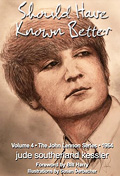


|
|
Glass Onion
Every Little Thing
Dear Sir or Madam...

The John Lennon Series by Jude Southerland Kessler
Hello, Goodbye Comment? Question?
|
|
Reference Library: You Can't Do That
From: bchs1k@menudo.uh.edu (Edward S. Chen)
A documentary covering the making of "A Hard Day's Night," from its inception to the creation of the screenplay, to the filming itself, to the eventual release. Includes rarely-seen and previously-unseen footage along with new interviews with cast, crew and others.
Another feather must go into the cap of Beatles video guru Ron Furmanek for "You Can't Do That," an intelligent and breezy look at the making of the movie "A Hard Day's Night." The main narrator is Phil Collins, whose claim to fame on this subject is having appeared as one of the screaming extras in the La Scala finale. The "See, I really was there" scene is a bit indulgent, but also very brief. It is also quite nice to finally have proof of Collins' longstanding claim. Otherwise, Collins does an admirable job, always careful to keep track of the line between interested narrator, and drooling fanboy. The documentary has a unique structure, moving neither chronologically, nor sequentially through the film. Despite that fact, the order is never confusing, and the "Dream On"-esque "stingers" from the original film remind the viewer what is being discussed while maintaining a breakneak pace from start to finish. Among the major players interviewed on-screen, Richard Lester and Walter Shenson share familar stories. Despite the fact these stories have been heard before, it is nice to have them collected in a single place. Further, besides Shenson and Lester's offices, the film offers the viewer a look at the contemporary interiors at Twickenham (site of much Beatles film history), and a brick wall exterior which is perhaps the only part of the studio not to have changed in 30 years. Other, less familar figures spotlighted include several extended interview bites with screenwriter Alun Owen, co-star Norman Rossington, and well-known Beatles actor Victor Spinetti. Spinetti even manages to work in his famous John Lennon impersonation on-camera. Wardrobe Designer Julie Harris was not supposed to be part of the assembly, but her stories (particularly the new anecdote about John Lennon's cap) round out the figures who were "there." Other than a handful of radio clips, the Beatles and Wilfrid Brambell do not represent themselves, but that is barely noticable. As has been indicated many times, that is not necessarily a handicap, as the Beatles can and do have some of the least reliable memories of what happened. Besides, the reminisces of the group about the film will surely be present in "Anthology." Of the celebrities not directly involved with the film, it is particularly interesting to see and hear Roger McGuinn's comments on the "Byrds pilgrammage to see AHDN" (continuing an ongoing debate in this newsgroup), and how the film changed their lives. Film critic Roger Ebert continues effusing his well-known love for the movie (with the most thought provoking comment being that had AHDN been *exactly* the same movie except in color it would not have been a classic), and Monkee Micky Dolenz sleepwalks through his brief appearance. (The producers were obviously trying to get Dolenz to make the transparent connection between AHDN and "The Monkees," but he didn't) The final group of interviews are with original fan club members. An interesting counterpoint can be made between UA's attempts to create a news story for promotional effect at the US premiere of the film, and Capitol's similar (although more successful) effort months earlier for the Beatles' arrival in the US. The contemporary footage of fans is nice, but perhaps a bit jarring considering the "timeless" nature of the rest of the film. As to the classic footage, Furmanek has done a nice job of cutting together the highlights from Walter Shenson's secondary crew. A topic not broached that would've been interesting is exactly why Shenson hired the folks to film "behind the scenes" footage in 1964, while the goal was apparently to keep the project as low-budget as possible. The original US and European trailers are also a welcome addition, and the merge from the brick wall backdrop in the present to the same wall in the trailer works well. I would be curious as to why they used the subtitled-in-French version of the European trailer rather than the more common British version. Of the other footage, Furmanek's identification of some well-known silent Abbey Road footage (much of it previously released in "The Compleat Beatles") is welcome, and the synching of Paul singing and the footage works well. Despite John Lennon's protestations about how the real Beatles *weren't* like their film counterparts, this footage moots that argument a bit. On the down side, some of Shenson's footage is a bit muddy (granted, they didn't have Apple's resources to restore the footage), and the fast pace leaves little time to reflect. The extra footage in the home video version is going to consist of the remainder of the "You Can't Do That" promo, and a handful of extra quotes from Shenson and Lester. MPI is also re-vamping their "Beatles Box" set such that "First US Visit" is replaced by "You Can't Do That." All in all, a great way to spend an hour, and most fans are going to pop in the original film for a marvelous double feature. Overall Grade: A
--
| ||||||||||||
|
|
Search this site
THIS MONOPHONIC MICROGROOVE RECORDING IS PLAYABLE ON MONOPHONIC AND STEREO PHONOGRAPHS.
IT CANNOT BECOME OBSOLETE. IT WILL CONTINUE TO BE A SOURCE OF OUTSTANDING SOUND REPRODUCTION,
PROVIDING THE FINEST MONOPHONIC PERFORMANCE FROM ANY PHONOGRAPH.
Original Content Copyright © 1995-2025 Adam Forrest
